Blog & Latest Updates
Fly Fishing Articles
Insects by Common Name


> > Mystery Creek # 199
About "Mystery Creeks": I love small streams, but some of my favorite little trout streams are too small and too fragile to publicize here. If you recognize one of these, you already understand why I'm keeping it a secret. These are the kinds of places that lose a little bit of their charm if you see someone else's week-old footprint, and I don't want to do that to them.
Closeup insects from Mystery Creek # 199
Kogotus nonus Stonefly Nymph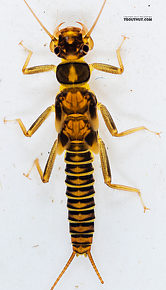 View 10 Pictures
View 10 Pictures
 View 10 Pictures
View 10 PicturesCollected July 28, 2019 from Mystery Creek #199 in Washington
Added to Troutnut.com by Troutnut on July 30, 2019
Added to Troutnut.com by Troutnut on July 30, 2019
Dolichopodidae True Fly Adult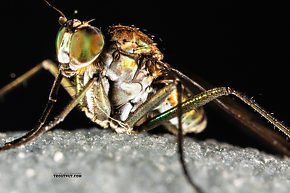 View 10 Pictures
View 10 Pictures
 View 10 Pictures
View 10 PicturesCollected July 28, 2019 from Mystery Creek #199 in Washington
Added to Troutnut.com by Troutnut on July 30, 2019
Added to Troutnut.com by Troutnut on July 30, 2019
Female Kogotus nonus Stonefly Adult View 18 Pictures
View 18 Pictures
 View 18 Pictures
View 18 PicturesCollected July 28, 2019 from Mystery Creek #199 in Washington
Added to Troutnut.com by Troutnut on July 30, 2019
Added to Troutnut.com by Troutnut on July 30, 2019
Lepidostoma (Little Brown Sedges) Little Brown Sedge Larva View 12 Pictures
View 12 Pictures
 View 12 Pictures
View 12 PicturesCollected July 28, 2019 from Mystery Creek #199 in Washington
Added to Troutnut.com by Troutnut on July 30, 2019
Added to Troutnut.com by Troutnut on July 30, 2019
Kogotus nonus Stonefly Nymph View 9 PicturesAlthough Kogotus and Rickeri nymphs may be difficult or impossible to tell apart, I captured an adult Kogotus nonus specimen in the air on the same day as several of these nymphs, and they are likely the same species.
View 9 PicturesAlthough Kogotus and Rickeri nymphs may be difficult or impossible to tell apart, I captured an adult Kogotus nonus specimen in the air on the same day as several of these nymphs, and they are likely the same species.
 View 9 PicturesAlthough Kogotus and Rickeri nymphs may be difficult or impossible to tell apart, I captured an adult Kogotus nonus specimen in the air on the same day as several of these nymphs, and they are likely the same species.
View 9 PicturesAlthough Kogotus and Rickeri nymphs may be difficult or impossible to tell apart, I captured an adult Kogotus nonus specimen in the air on the same day as several of these nymphs, and they are likely the same species.Collected July 28, 2019 from Mystery Creek #199 in Washington
Added to Troutnut.com by Troutnut on July 30, 2019
Added to Troutnut.com by Troutnut on July 30, 2019
Cinygmula (Dark Red Quills) Mayfly Nymph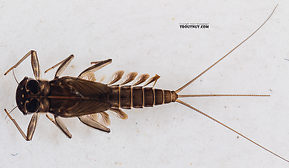 View 7 Pictures
View 7 Pictures
 View 7 Pictures
View 7 PicturesCollected July 28, 2019 from Mystery Creek #199 in Washington
Added to Troutnut.com by Troutnut on July 30, 2019
Added to Troutnut.com by Troutnut on July 30, 2019
Serratella micheneri (Little Western Dark Hendrickson) Mayfly Nymph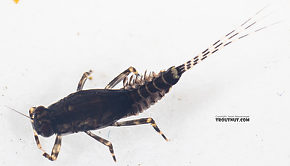 View 6 Pictures
View 6 Pictures
 View 6 Pictures
View 6 PicturesCollected July 28, 2019 from Mystery Creek #199 in Washington
Added to Troutnut.com by Troutnut on July 30, 2019
Added to Troutnut.com by Troutnut on July 30, 2019
Suwallia pallidula (Sallfly) Stonefly Nymph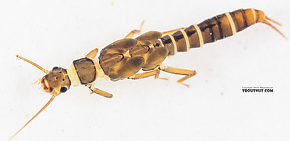 View 6 PicturesThis specimen keys out to Suwallia, for which I did not find any nymph species keys. However, I'm placing it in Suwallia pallidula because I caught a few adults in the same spot that closely resembled the abundant nymphs and keyed them out to species. Features I noted under the microscope when keying this specimen to genus included apical (Apical: Close to the apex; tip or end.) hairs of cercal segments that were directed at posterior (Posterior: Toward the back of an organism's body. The phrase "posterior to" means "in back of.") angles, and the longest apical (Apical: Close to the apex; tip or end.) hairs of distal (Distal: Far from the point of attachment or origin; near the tip.) segments were shorter than their following segment.
View 6 PicturesThis specimen keys out to Suwallia, for which I did not find any nymph species keys. However, I'm placing it in Suwallia pallidula because I caught a few adults in the same spot that closely resembled the abundant nymphs and keyed them out to species. Features I noted under the microscope when keying this specimen to genus included apical (Apical: Close to the apex; tip or end.) hairs of cercal segments that were directed at posterior (Posterior: Toward the back of an organism's body. The phrase "posterior to" means "in back of.") angles, and the longest apical (Apical: Close to the apex; tip or end.) hairs of distal (Distal: Far from the point of attachment or origin; near the tip.) segments were shorter than their following segment.
 View 6 PicturesThis specimen keys out to Suwallia, for which I did not find any nymph species keys. However, I'm placing it in Suwallia pallidula because I caught a few adults in the same spot that closely resembled the abundant nymphs and keyed them out to species. Features I noted under the microscope when keying this specimen to genus included apical (Apical: Close to the apex; tip or end.) hairs of cercal segments that were directed at posterior (Posterior: Toward the back of an organism's body. The phrase "posterior to" means "in back of.") angles, and the longest apical (Apical: Close to the apex; tip or end.) hairs of distal (Distal: Far from the point of attachment or origin; near the tip.) segments were shorter than their following segment.
View 6 PicturesThis specimen keys out to Suwallia, for which I did not find any nymph species keys. However, I'm placing it in Suwallia pallidula because I caught a few adults in the same spot that closely resembled the abundant nymphs and keyed them out to species. Features I noted under the microscope when keying this specimen to genus included apical (Apical: Close to the apex; tip or end.) hairs of cercal segments that were directed at posterior (Posterior: Toward the back of an organism's body. The phrase "posterior to" means "in back of.") angles, and the longest apical (Apical: Close to the apex; tip or end.) hairs of distal (Distal: Far from the point of attachment or origin; near the tip.) segments were shorter than their following segment.Collected July 28, 2019 from Mystery Creek #199 in Washington
Added to Troutnut.com by Troutnut on July 30, 2019
Added to Troutnut.com by Troutnut on July 30, 2019
Ameletus (Brown Duns) Mayfly Nymph View 6 Pictures
View 6 Pictures
 View 6 Pictures
View 6 PicturesCollected July 28, 2019 from Mystery Creek #199 in Washington
Added to Troutnut.com by Troutnut on July 30, 2019
Added to Troutnut.com by Troutnut on July 30, 2019
Female Ameletus (Brown Duns) Mayfly Spinner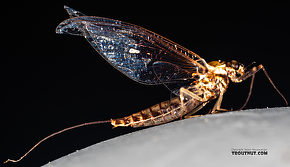 View 13 PicturesI found this female already spent (Spent: The wing position of many aquatic insects when they fall on the water after mating. The wings of both sides lay flat on the water. The word may be used to describe insects with their wings in that position, as well as the position itself.) and nearly dead, laying in the surface film of a very tiny spring seep (inch-deep water) in the valley of a very small trout stream.
View 13 PicturesI found this female already spent (Spent: The wing position of many aquatic insects when they fall on the water after mating. The wings of both sides lay flat on the water. The word may be used to describe insects with their wings in that position, as well as the position itself.) and nearly dead, laying in the surface film of a very tiny spring seep (inch-deep water) in the valley of a very small trout stream.
 View 13 PicturesI found this female already spent (Spent: The wing position of many aquatic insects when they fall on the water after mating. The wings of both sides lay flat on the water. The word may be used to describe insects with their wings in that position, as well as the position itself.) and nearly dead, laying in the surface film of a very tiny spring seep (inch-deep water) in the valley of a very small trout stream.
View 13 PicturesI found this female already spent (Spent: The wing position of many aquatic insects when they fall on the water after mating. The wings of both sides lay flat on the water. The word may be used to describe insects with their wings in that position, as well as the position itself.) and nearly dead, laying in the surface film of a very tiny spring seep (inch-deep water) in the valley of a very small trout stream.Collected July 28, 2019 from Mystery Creek #199 in Washington
Added to Troutnut.com by Troutnut on July 30, 2019
Added to Troutnut.com by Troutnut on July 30, 2019
Start a Discussion of Mystery Creek # 199:
Top 10 Fly Hatches
Top Gift Shop Designs
Eat mayflies.
Top Insect Specimens
Miscellaneous Sites
Troutnut.com is copyright © 2004-2024 Jason
Neuswanger (email Jason). See my FAQ for information about use of my images.
 privacy policy
privacy policy
